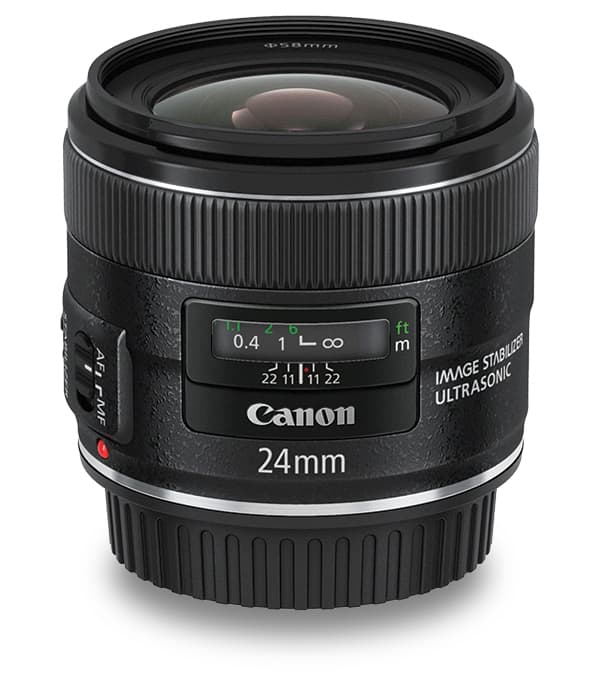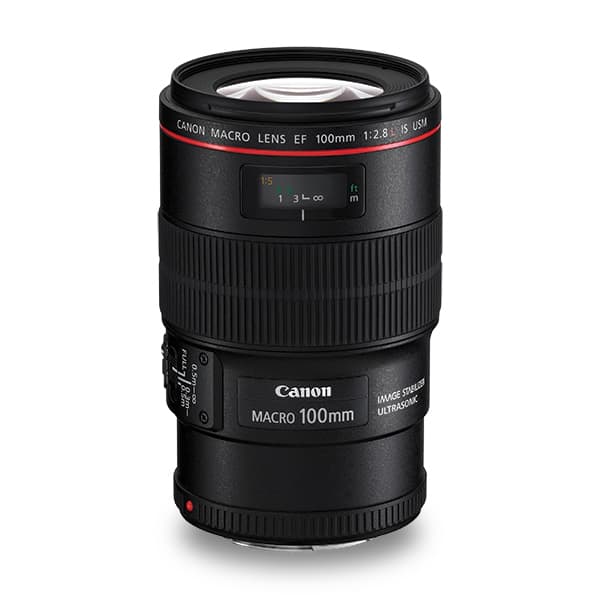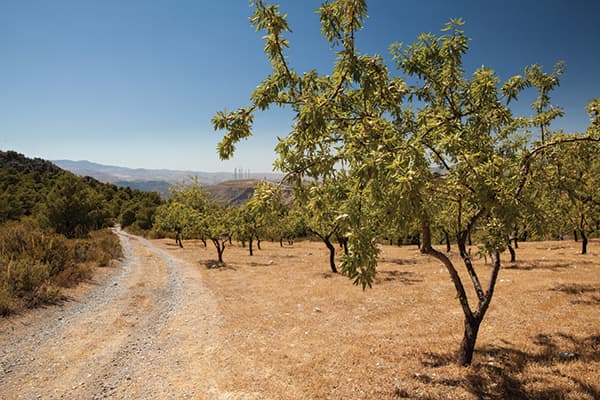
Using a 24mm lens enables you to capture a wider vista and have lots of depth of field. It’s a good choice for travel photography
If you own a Canon DSLR, you’ve probably browsed through the lens listings on the company’s website and discovered that there are a heck of a lot to chose from – more than 70, in fact. And that’s just from Canon; there are other options from third-party manufacturers such as Sigma, Tamron, Tokina and Zeiss as well.
In this article, we’re going to identify the key prime lenses to target for your collection. Why prime lenses? Well, they are the optics that generally produce the best image quality because there’s no compromise in the design to cater for shifting focal length. You also tend to get larger apertures than comparable zoom lenses, giving you more control over depth of field and greater scope to use fast shutter speeds when light levels fall.
Raising the standard

A 50mm lens such as the Canon EF 50mm f/1.4 USM makes a good walkaround lens for days out
Even though you probably have a standard zoom lens, one that covers a focal length equivalent to 50mm, a 50mm prime lens makes a great addition to your kit. For a start, this lens is often (but not always) smaller and lighter than a zoom lens. Invariably it will also offer a larger maximum aperture to give you tighter control over depth of field, but it’s also a good walkaround optic for when you want to keep life simple. A 50mm equivalent focal length produces an angle of view that’s close to that of our eyes, making it easy to assess composition before you lift the camera to your eye.
If you use a full-frame camera then there are a few 50mm lenses available to you. Canon currently has three 50mm optics on offer, the EF 50mm f/1.8 STM, EF 50mm f/1.4 USM and the EF 50mm f/1.2L USM with street prices of around £100, £245 and £1,130 respectively. Of this trio the EF 50mm f/1.4 USM is our pick, being less than half the weight of and significantly more affordable than the EF 50mm f/1.2L USM. Plus the maximum aperture is only a little smaller. It lacks the weather-seals of the L-series lens, but its focusing speed is pretty good despite having ultrasonic motor-driven autofocusing rather than ring-type and there’s full-time manual override if you need it.
On an APS-C format Canon DSLR, a 50mm lens produces images comparable with an 80mm optic on full-frame, making the EF 50mm f/1.4 USM a great choice for portraits. And the fact that it isn’t the sharpest optic when it’s fully-open isn’t the worst news for portrait shots.
Sigma’s 50mm f/1.4 DG HSM Art (£570) lens also deserves a mention here. Its a stellar optic and the one to go for if you want the best image quality at a reasonable price, but it’s also big (85.4 x 99.9mm) and heavy (815g) for the focal length.
Owners of APS-C format SLRs wishing to emulate the look of a 50mm optic on full-frame need to invest in a shorter focal length. The Canon EF 35mm f/2 IS USM (£380) makes a great choice. It’s actually a full-frame lens, but on APS-C cameras it delivers an effective focal length of 56mm. It’s also a nice, sharp optic that comes with an excellent Image Stabilisation system that enables you to handhold the camera as light levels fall.
Something wide

Canon EF 24mm f/2.8 IS USM
If you’re looking for a wideangle prime for shooting landscapes, the Canon EF 24mm f/2.8 IS USM (£455) makes a fine choice, being just 55.7mm long and weighing in at only 280g. However, if you want a wider maximum aperture, there are a couple of options: the Canon EF 24mm f/1.4L II USM (£1,099) or the Sigma 24mm f/1.4 DG HSM Art (£599). The Canon lens is weatherproofed, while the Sigma isn’t, but the price makes the Sigma lens much more attractive. And there’s no need to worry that you’ll be skimping on image quality, as the Sigma optic produces superb results that are sharp at the centre and have wonderfully smooth out-of-focus areas.
Naturally, this lens is a little bit bigger (85 x 90.2mm) and heavier (665g) than the f/2.8 optic, but it’s superb, making the extra load worthwhile. Plus the wider maximum aperture gives you greater ability to restrict depth of field – something that becomes harder as focal length decreases.
If you want to go wider still, take a look at the Sigma 20mm f/1.4 DG HSM Art (£629). Like the other Sigma lenses we’ve recommended here, this is one of Sigma’s Art lenses, a relatively recent introduction of impressively good lenses. This lens also has the honour of being the first 20mm optic to feature a maximum aperture of f/1.4 and constructing it has required an unusually large double-aspherical lens that measures 59mm in diameter.
To reduce chromatic aberration, which can be problematic with very wideangle lenses, two of the 15 glass elements are ‘F’ Low-Diversion (FLD) type and five are Special Low Dispersion (SLD) type. Sigma has also used its Super Multi-Layer Coatings to cut down flare and there’s a petal-shaped lens hood permanently attached to the front of the lens.
While it’s designed for use with full-frame cameras, the 20mm f/1.4 DG HSM Art can also be mounted on APS-C format Canon DSLRs on which the lens has an equivalent focal length of 32mm, making a nice fast, wide-angle option.
If you shoot wide open you’ll notice that the corners are around 2EV darker than the centre of the frame and quite a bit softer, but the centre is super-sharp and the fall-off can be used to creative advantage. Closing down to f/3.2 almost completely eradicates the vignetting while corner sharpness picks up at f/4.
One area where this prime particularly impresses is with the control of lens distortion; straight lines do bend, but it’s well within acceptable limits for a 20mm optic. Chromatic aberration is there if you look for it, but it’s not a major problem at all.
Portrait lenses

Canon EF 85mm f/1.8 USM
Focal lengths longer than 50mm (on full-frame) are usually considered to produce the most flattering results and 85mm lenses are particularly favoured. Canon’s EF 85mm f/1.8 USM (£280) is a very popular choice and it’s the lens we recommend, balancing price with image quality and a larger aperture well. Like the 50mm f/1.4 it’s a little soft when used wide open, but many portrait sitters will thank you for that. Close down to f/2.8, however, and the details come to life and they stay that way up to f/11.
Canon also has the 85mm f/1.2L II USM, but at a street price of around £1,499 you have to really want the very narrow depth of field that the 1/3 stop wider aperture brings. Okay, it’s weather-proofed as well, but you’ll have to be really, really careful with focusing if you’re shooting at f/1.2.
As we mentioned earlier, the Canon EF 50mm f/1.4 USM makes a good portrait lens for APS-C format DSLRs, but the (bigger, heavier and more expensive) Sigma 50mm f/1.4 DG HSM A is even better.
Get closer

Shooting with a true macro lens enables you to achieve life-size reproduction, and Canon’s 100mm option gives a comfortable working distance
Though some zoom lenses may have the word ‘Macro’ on the barrel, they are not true macro lenses – they just allow you to focus a little closer than normal. If you want to get 1:1 (life-size) reproduction you have go for a prime lens. Canon has five full-frame compatible macro lenses on offer but the EF 100mm f/2.8L IS Macro USM gets the nod from us. With a street price of around £660, it’s quite a bit more expensive than the non-L version, the EF 100mm f/2.8 Macro USM (£399), but you get weatherproofing and Canon’s Image Stabilizer built-in. And unusually for Canon, which likes to make you pay extra for lens hoods, there’s one supplied.

EF 100mm f/2.8L IS Macro USM
The ‘hybrid’ stabilisation system is specifically designed with close-up photography in mind because it can correct for the up-down and side-to-side movements that can be an issue with handheld macro photography. However, it’s worth bearing in mind that the claimed compensation reduces from four stops to two stops at 1:1 magnification.
With a closest focusing distance of 30cm (from the sensor to the subject), the EF 100mm f/2.8L IS Macro USM gives a comfortable working distance so you don’t have to be practically squashing your subject to get life-size reproduction. Photographers shooting with crop-sensor DSLRs can also use Canon’s 100mm macro lenses, but the Canon EF-S 60mm f/2.8 Macro USM is specifically designed for use on EF-S cameras and it retails for around £320, making it an attractive option. Like the EF 100mm f/2.8L IS Macro USM, it’s very sharp and maintains the sharpness well at small apertures.
Focal length equivalence
Most Canon prime lenses are designed for use on full-frame cameras, but they can still be mounted on APS-C format or EF-S mount cameras like the EOS 1300D, EOS 750D, EOS 760D and EOS 80D. However, the smaller sensor size effectively crops into the image circle that these EF-mount lenses produce, making them look like longer optics with a magnification factor of 1.6x. That means a full-frame 100mm lens has an effective focal length of 160mm on an APS-C format camera.

On an APS-C format camera like the 80D, a 200mm lens gives an effective focal length of 320mm, which enables tight framing of distant subjects.
Longer lenses
Canon makes some fantastic long telephoto prime lenses, with some of them such as the EF 200mm f/2.8L II USM (average street price £599), the EF 300mm f/4L IS USM (£999) and the EF 400mm f/5.6L USM (£959) costing less than a popular high-end zoom such as the Canon EF 70-200mm f/2.8 L IS II USM (£1,599).
However, longer and/or faster optics that are designed to cater for the needs of professional wildlife and sport photographers are very expensive. The EF 200mm f/2L IS USM and the EF 400mm f/2.8L IS II USM, for example – which give greater scope for blurring backgrounds – retail for approximately £4,350 and £7,700 respectively. Meanwhile the EF 500mm f/4L IS II USM, which appeals to bird photographers, will set you back by around £6,700.








